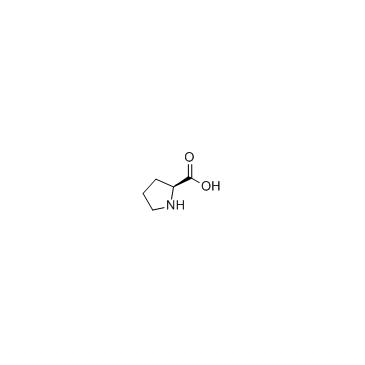Proline

Proline structure
|
Common Name | Proline | ||
|---|---|---|---|---|
| CAS Number | 147-85-3 | Molecular Weight | 115.131 | |
| Density | 1.2±0.1 g/cm3 | Boiling Point | 252.2±33.0 °C at 760 mmHg | |
| Molecular Formula | C5H9NO2 | Melting Point | 228 °C (dec.)(lit.) | |
| MSDS | Chinese USA | Flash Point | 106.3±25.4 °C | |
|
Mechanism of chemical activation of sodium chloride in the presence of amino acids.
Food Chem. 166 , 301-8, (2014) Sodium chloride has been shown to promote chlorination of glycerol during thermal processing. However, the detailed mechanism of this reaction is not well understood. Preliminary experiments have indicated that the reaction mixture should contain an amino aci... |
|
|
Metabolic network capacity of Escherichia coli for Krebs cycle-dependent proline hydroxylation.
Microb. Cell Fact. 14 , 108, (2015) Understanding the metabolism of the microbial host is essential for the development and optimization of whole-cell based biocatalytic processes, as it dictates production efficiency. This is especially true for redox biocatalysis where metabolically active ce... |
|
|
Injectable microcarriers as human mesenchymal stem cell support and their application for cartilage and degenerated intervertebral disc repair.
Eur. Cell. Mater. 29 , 70-80; discujssion 80-1, (2015) Degeneration of the intervertebral disc (IVD) is a progressive and chronic process, and the high incidence of discogenic disorders calls for new therapeutic approaches, such as cell-based therapies using three dimensional cultures and mesenchymal stem cells (... |
|
|
Self-immolative polycations as gene delivery vectors and prodrugs targeting polyamine metabolism in cancer.
Mol. Pharm. 12(2) , 332-41, (2015) Polycations are explored as carriers to deliver therapeutic nucleic acids. Polycations are conventionally pharmacological inert with the sole function of delivering therapeutic cargo. This study reports synthesis of a self-immolative polycation (DSS-BEN) base... |
|
|
Immortalisation with hTERT Impacts on Sulphated Glycosaminoglycan Secretion and Immunophenotype in a Variable and Cell Specific Manner.
PLoS ONE 10 , e0133745, (2015) Limited options for the treatment of cartilage damage have driven the development of tissue engineered or cell therapy alternatives reliant on ex vivo cell expansion. The study of chondrogenesis in primary cells is difficult due to progressive cellular aging ... |
|
|
The infrapatellar fat pad from diseased joints inhibits chondrogenesis of mesenchymal stem cells.
Eur. Cell. Mater. 30 , 303-14, (2015) Cartilage repair by bone marrow derived mesenchymal stem cells (MSCs) can be influenced by inflammation in the knee. Next to synovium, the infrapatellar fat pad (IPFP) has been described as a source for inflammatory factors. Here, we investigated whether fact... |
|
|
The Application of Three-Dimensional Printing in Animal Model of Augmentation Rhinoplasty.
Ann. Biomed. Eng. 43 , 2153-62, (2015) The role of three-dimensional (3D) printing has expanded in diverse areas in medicine. As plastic surgery needs to fulfill the different demands from diverse individuals, the applications of tailored 3D printing will become indispensable. In this study, we ev... |
|
|
Chondrogenesis of mesenchymal stem cells in an osteochondral environment is mediated by the subchondral bone.
Tissue Eng. Part A 20(1-2) , 23-33, (2014) In articular cartilage repair, cells that will be responsible for the formation of repair tissue are often exposed to an osteochondral environment. To study cartilage repair mechanisms in vitro, we have recently developed a bovine osteochondral biopsy culture... |
|
|
Human osteoarthritic synovium impacts chondrogenic differentiation of mesenchymal stem cells via macrophage polarisation state.
Osteoarthr. Cartil. 22(8) , 1167-75, (2014) Mesenchymal stem cells (MSCs) are a promising cell type for the repair of damaged cartilage in osteoarthritis (OA). However, OA synovial fluid and factors secreted by synovium impede chondrogenic differentiation of MSCs, and the mechanism responsible for this... |
|
|
Simultaneous silencing of multiple RB and p53 pathway members induces cell cycle reentry in intact human pancreatic islets.
BMC Biotechnol. 14 , 86, (2014) Human pancreatic islet structure poses challenges to investigations that require specific modulation of gene expression. Yet dissociation of islets into individual cells destroys cellular interactions important to islet physiology. Approaches that improve tra... |